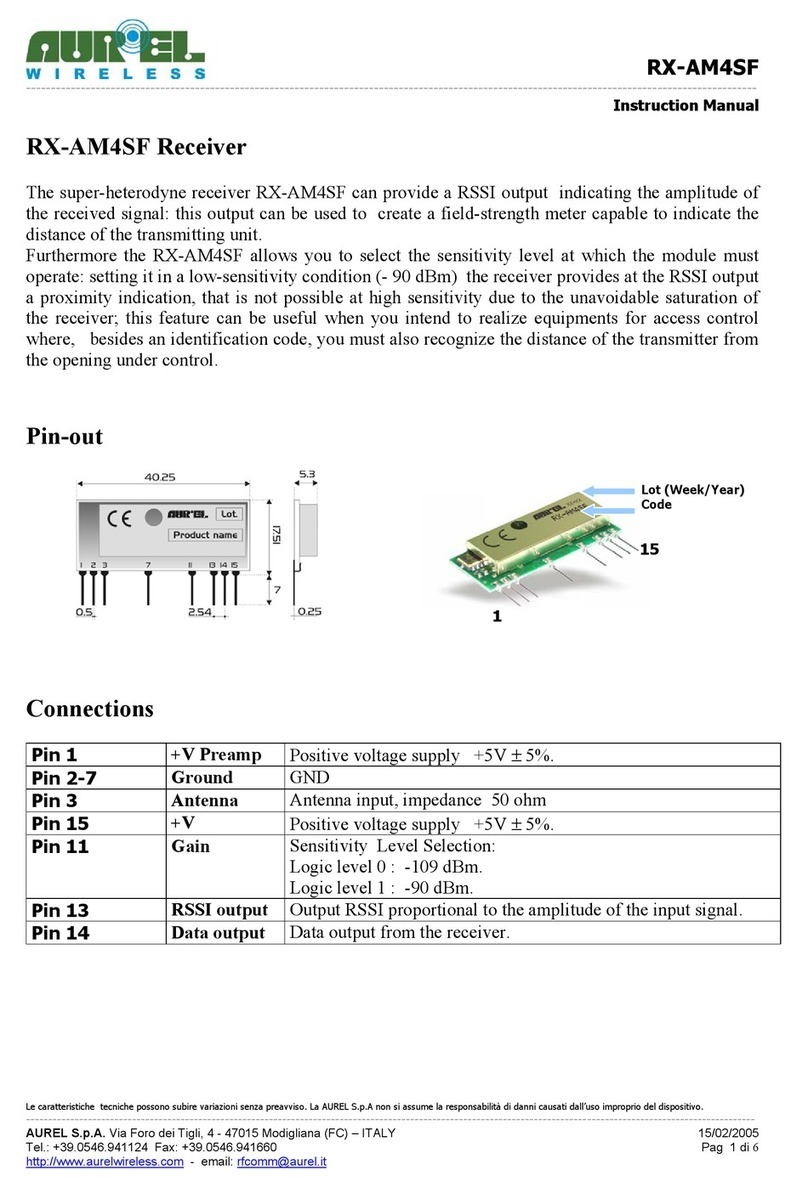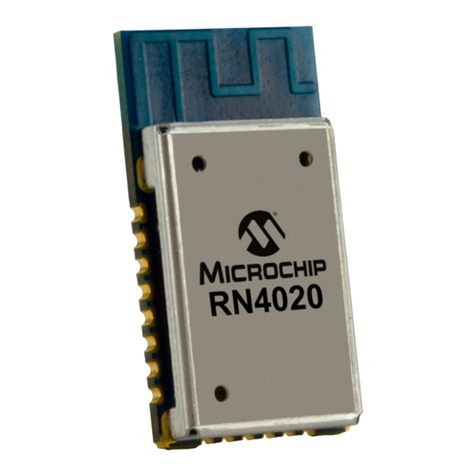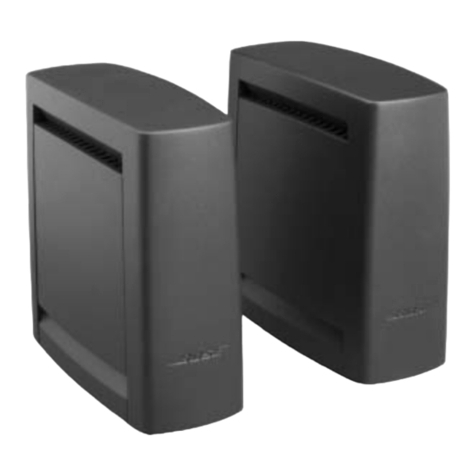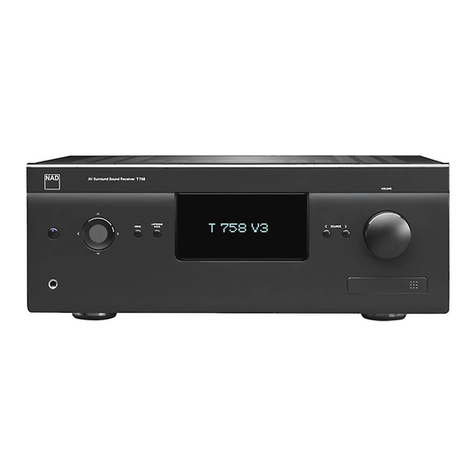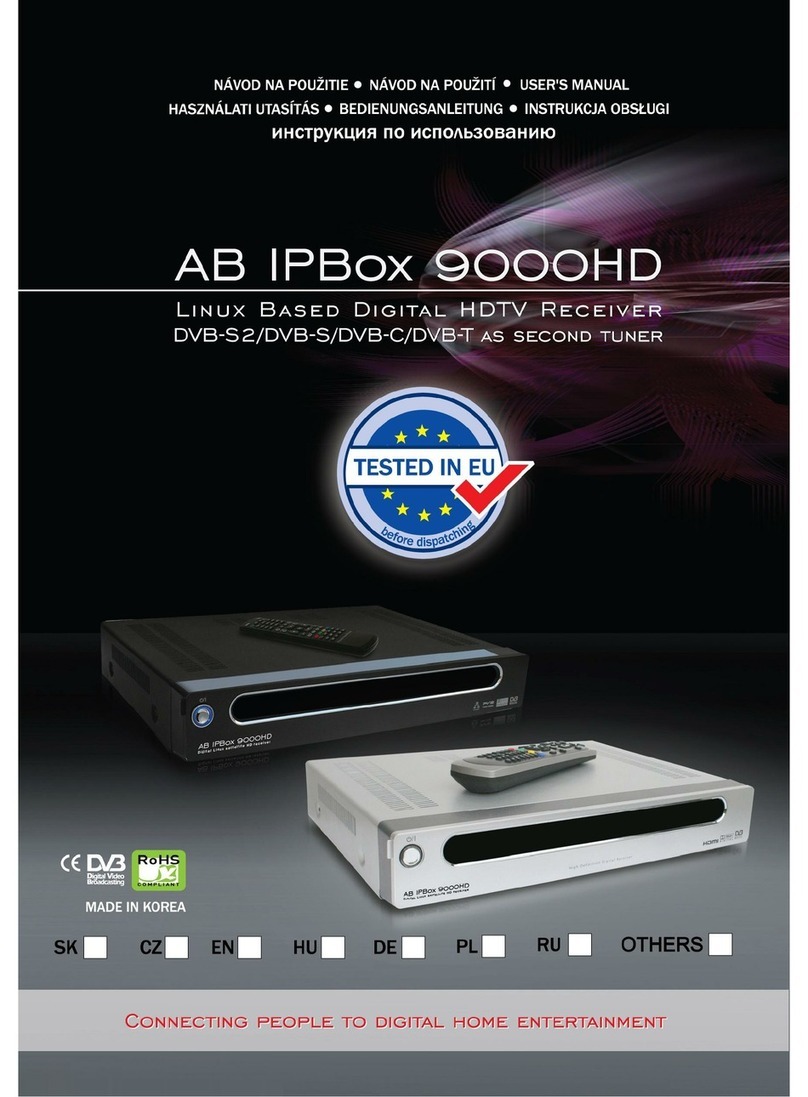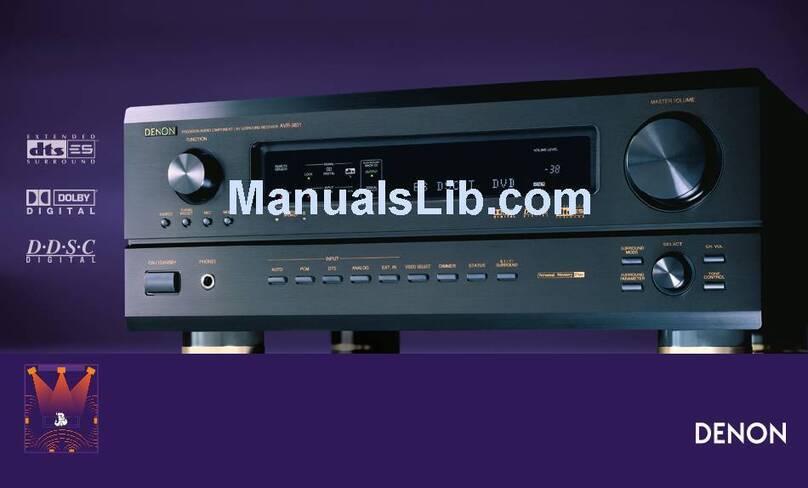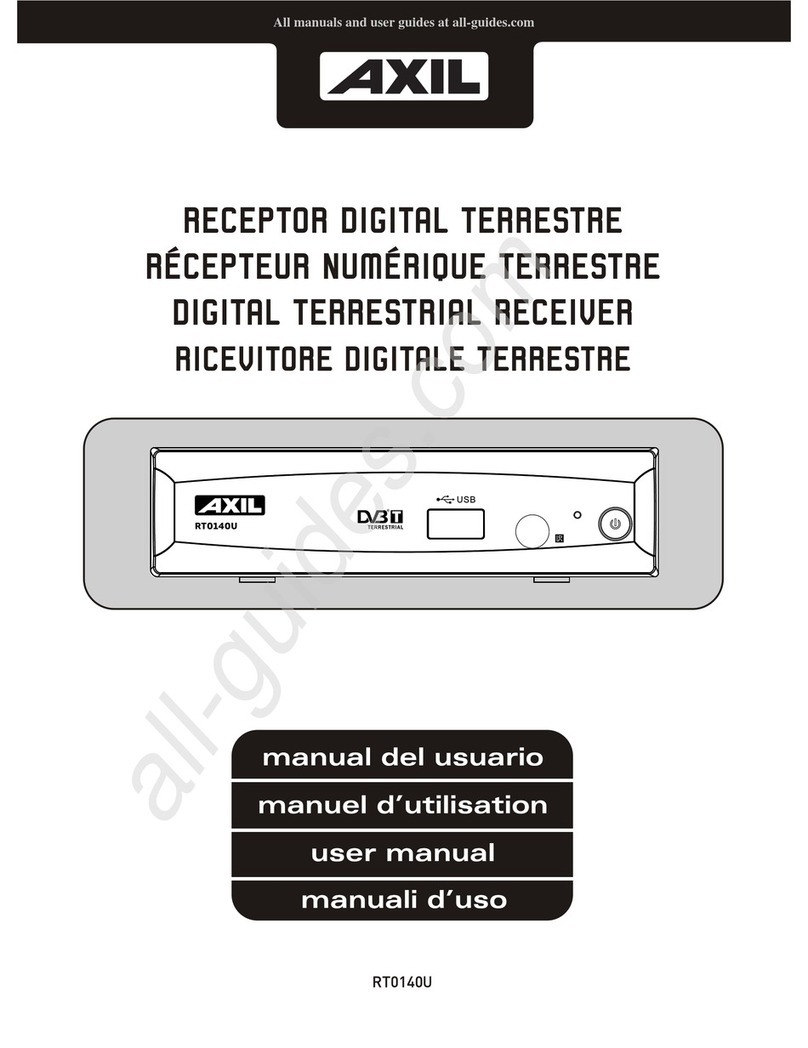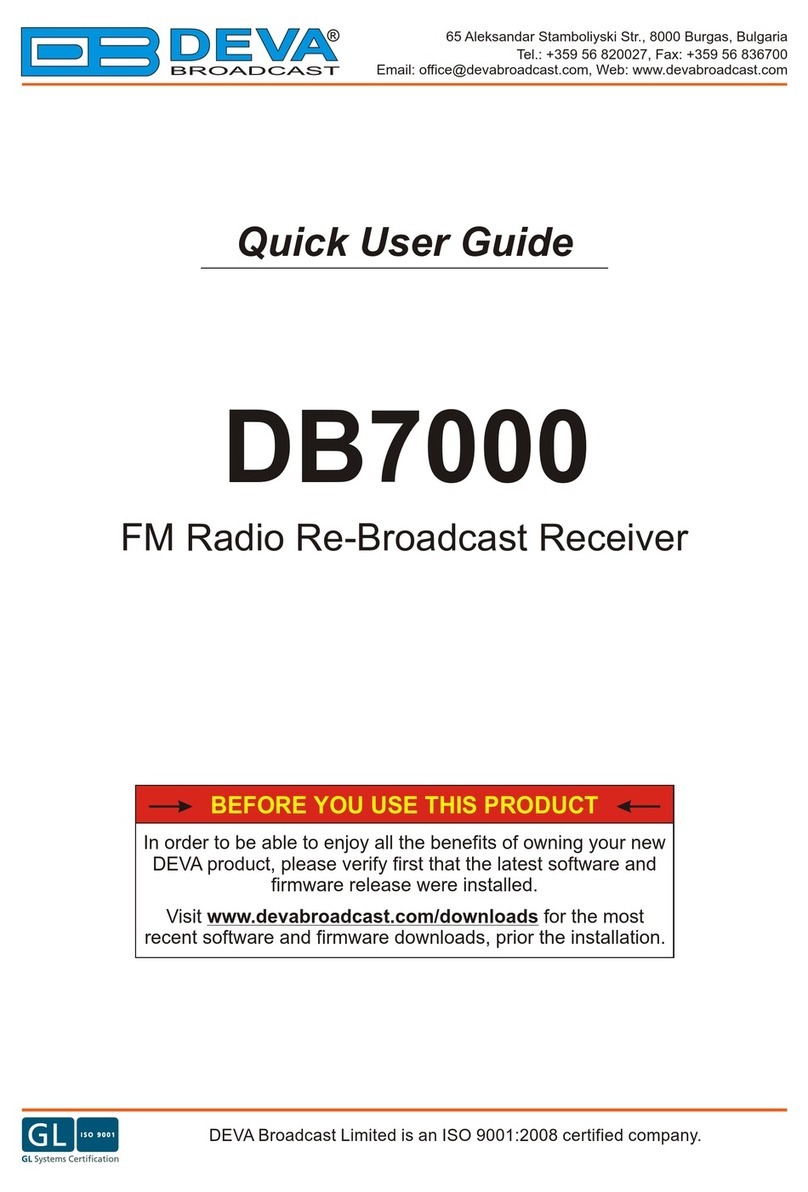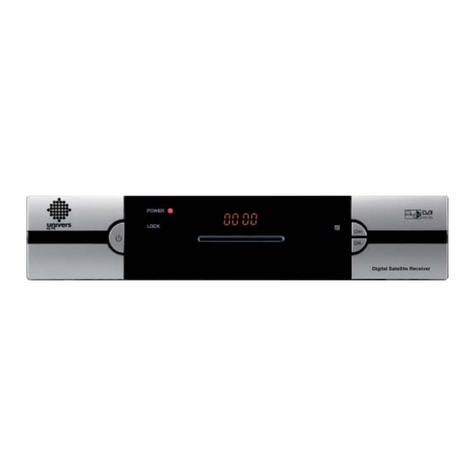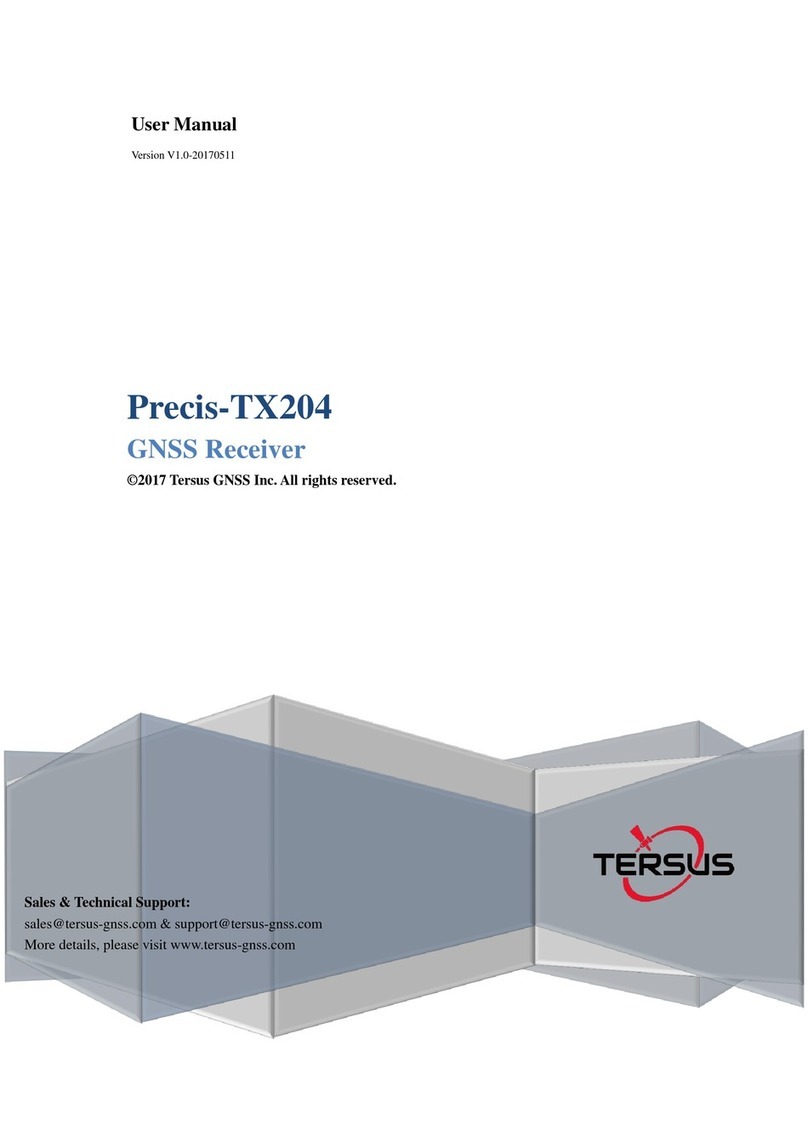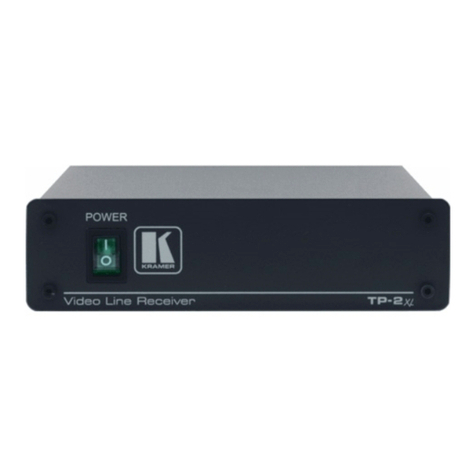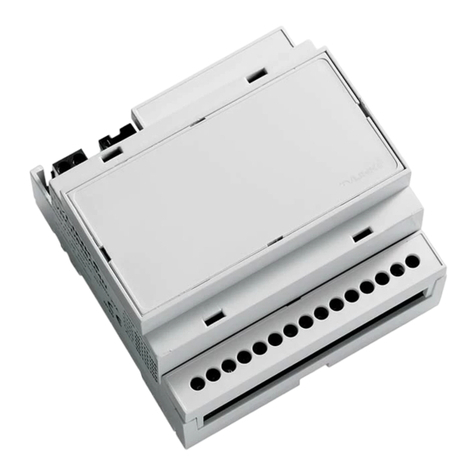Clear TV Digimax RF User manual

Instrucciones de servicio Página 27
Operating instructions Page 7
Model: _________________________________
Owner name: _________________________________
Date purchased _________________________________
Distributor name: _________________________________
Phone number: _________________________________
DIGIMAX RF
TV Listening System
www.ClearTVAudio.com

4
3
2
4
3
2
1
28
2
3
4
5
6
7
12
9
11
10
81615
13
14
19
20
21 21
2223 24 25 26 27
17
18
Quick overview
These operating instructions allow you to
fold out the rst 2 pages. These pages show
images of the Digimax RF with identication by
numbers.
Overview headset:
1 Volume control
2 Loud speaker ear adapters
3 Battery compartment
4 Status LED
5 Pairing button (connect)
6 Balance
7 Tone adjustment left / right
Overview neckloop:
8 On/Off switch (On / Off)
9 Volume control
10 Induction loop
11 Breakaway safety connection
12 Battery compartment
13 Status LED
14 Pairing button (connect)
15 Balance
16 Tone adjustment
Overview transmitter:
17 Charging cradle
18 Charge LED for receiver in charging
cradle
19 Replacement battery charging bay
20 Charge LED for replacement battery
charging bay
21 Transmitting LED indicator
Overview accessories:
22 Power supply connection
23 USB connection
24 AUDIO, MIC / USB selector switch
25 Female connector for connection to a
sound source (green)
26 Female connector for connection to a
microphone (black) – optional
27 Pairing button (connect)
28 Transparent cover
29 Digital optical cable (Toslink)
30 S/PDIF converter
31 L/R audio cable
32 Microphone
Vista general
Puede desplegar las dos primeras páginas
de este manual de instrucciones. En estas
páginas hay las imágenes del Digimax RF
con numeración.
Vista general de los auriculares:
1 Regulador del volumen
2 Adaptadores para altavoces
3 Compartimento de la batería
4 Led de estado
5 Botón de emparejamiento (conectar)
6 Balance
7 Ajuste del sonido a izquierda y
derecha
Vista general de el lazo de anillo:
8 Interruptor de enc./ apag. (On / Off)
9 Regulador del volumen
10 Bucle de inducción
11 Protección contra estrangulamiento
12 Compartimento de la batería
13 Led de estado
14 Botón de emparejamiento (conectar)
15 Balance
16 Ajuste del sonido
Vista general del emisor:
17 Compartimento de carga
18 Led de carga para receptor en el
compartimento de carga
19 Compartimento de carga para la
batería de sustitución
20 Led compartimento de carga para la
batería de sustitución
21 Enviar led de estado
Vista general de accesorios:
22 Conexión para cable de red
23 Conexión USB
24 Conmutador AUDIO, MIC / USB
25 Casquillo para la conexión a una
fuente de sonido (verde)
26 Casquillo para la conexión a un
micrófono (negro) – opcional
27 Botón de emparejamiento (conectar)
28 El revestimiento transparente
29 Cable óptico digital (Toslink)
30 Convertidor S/PDIF
31 Cable de sonido I/D
32 Micrófono
29
30
31
32

7
Table of contents Page
Quick overview 6
Overview headphone 6
Overview neckloop 6
Overview transmitter 6
Overview accessories 6
Safety information 8
Package Contents 9
Set up / connections 10
Preferred connections 11
Connecting the transmitter to an RCA female jack 11
Connecting the transmitter to a headphone jack 11
Alternative connections 12
Connecting the TV to the S/PDIF converter 12
Connecting the S/PDIF converter to the transmitter 12
Connecting the transmitter to the microphone (optional) 13
Connecting the transmitter to the USB connector 13
Connecting the transmitter to the power supply 14
How to use 14
Digimax RF with under the chin headset receiver 14
Digimax RF neckloop 15
Safety lock in the neckloop 16
Listening with the 3.5 mm stereo output 16
Pairing of the transmitter and the receiver 17
Balance control 18
Tone control 18
Volume control 19
Transparent cover 19
Range 19
Battery charging 20
Cleaning and care 21
Cleaning the transmitter and the receiver 21
Cleaning the silicone ear adapters 21
Replacing the silicone ear adapters 21
Important information 22
Warranty 22
Environmental information/disposal 23
Troubleshooting 24
Technical Data 26

98
Safety information
• Before you begin operating this device, read these instructions carefully
and completely.
• Please retain these operating instructions to ensure that they are
accessible at any time for other users.
• This device is designed foroperation in dry interior spaces, with aroom
temperature of 50° F to 95° F / 10° C to 35 °C.
• Please handle the device and accessories carefully and install them only
in low-dust and clean locations.
• Clean the transmitter and the receiver regularly. For hygienic reasons, the
soft silicone ear adapters should be cleaned regularly. Please replace
as necessary with the soft silicone ear adapters, offered as special
accessories.
• Paints and furniture polishes can degrade the rubber feet of the
transmitter and therefore they may cause surface damage to your
furniture.
• To power the transmitter, use only the provided power supply.
Caution:
The receiver volume can be set to a high level. Please comply with the
following information to protect your ears or the ears of persons with normal
hearing, especially children, from hearing damage due to high volume levels.
1. Set the volume at a low level before you put the receiver on.
2. During use, adjust the volume to a level comfortable to you.
3. Before using the Digimax RF neckloop with a heart pacemaker, please
contact your physician or the manufacturer of the pacemaker to ensure
that the pacemaker is not subjected to interference.
4. If you use other medical devices, please use the Digimax RF only when
adhering to the safety information/safety directives of your physician or
the manufacturer.
Safety information for the lithium polymer battery
The battery used in Digimax RF is a lithium polymer battery, which was
produced in accordance with the most current provisions and safety
regulations. The battery can be damaged when misused or if not used
according to the specications; in this case Ear Technology Corporation
accepts no liability.
Warning!
The following risks exist in extreme cases:
– Overheating
– Fire
– Explosion
– Smoke and gas
• Do not heat the battery above 158° F / 70° C, e.g., through sun radiation
or by casting it into re.
• Do not subject the battery to moisture.
• Do not short circuit the battery
• Do not disassemble or deform the battery.
• Store device/battery in a cool and dry place at room temperature.
• Use only the provided charger for the battery.
• Recharge the battery in the device regularly by placing the receiver in the
transmitter cradle when not in use.
• Charge the battery only at ambient temperatures of 50° F to 104° F /
10° C to 40° C.
• Do not recharge the battery if the device is clearly damaged.
• Please return defective device or devices with worn out batteries to your
retailer.
Package contents
1 Digimax RF receiver: under the chin headset receiver or neckloop
1 Digimax RF transmitter
1 battery AP12A
1 screwdriver
1 power supply
1 audio connection cable with 3.5 mm stereo jack
1 audio adapter 3.5 mm to a 1/4” stereo jack
1 RCA adapter
1 pair of additional silicone ear adapters small
(with under the chin headset receiver)
1 S/PDIF digital "analog audio converter

)
)
)
)
DC 12V
USB AUDIO MIC CONNECT
USB AUDIO
MIC
AUDIO OUT
LR
DC 12V
USB AUDIO MIC CONNECT
USB AUDIO
MIC
28
1110
Congratulations on the purchase of your Digimax RF system. You have
purchased a reliable state-of-the-art device. Please review these operating
instructions carefully to ensure that you set up the device correctly and that
you are familiar with all functions of the device.
Set up / connections
Turn off the sound source before connecting the transmitter.
Plug the provided audio connection cable 28 into the green “Audio” female
connector 25 of the transmitter.
Several options exist to connect the Digimax RF to a sound source (e.g. TV,
computer, etc.).
Please check the output connection options of your sound source.
– RCA female connector
– Headphone connection
– External microphone
– USB connection (e.g. computer)
– S/PDIF digital output–when using digital to analog converter
(DAC). If your TV has RCA audio outputs, the included S/PDIF
converter is not necessary.
25
28
Preferred Connections
Connecting the transmitter to an RCA female jack
Connect the adapter cable with the RCA plugs 29 to the audio connection
cable 28.
Plug the RCA plugs into the RCA connection of your sound source.
• Ensure that the white connection is connected to the white connection of
your sound source.
• Ensure that the red connection is connected to the red connection of your
sound source.
If your TV has RCA audio outputs, the included S/PDIF converter is not
necessary.
Connecting the transmitter to a headphone jack
Plug the audio connection cable 28 into the headphone jack of your sound
source.
You may need to use the 1/4” (6.5 mm) headphone plug adapter (included)
to connect to your sound source. Set the volume of your sound source to a
comfortable level.
28 29

To Digimax RF transmitterFrom TV
Digital coaxial cable
(not included)
Digital optical cable
(Toslink)
L/R audio cable
S/PDIF converter
DC 12V
USB AUDIO MIC CONNECT
USB AUDIO
MIC
L R
1312
Alternative Connections
IMPORTANT: S/PDIF converter
If your TV does not have analog audio outputs, use the S/PDIF converter (included).
Connecting the TV to the S/PDIF converter
Using the provided Toslink cable 29, connect your TV (optical audio out) to
the S/PDIF converter 30 (optical).
Connecting the S/PDIF converter to the transmitter
Connect the adapter cable with the RCA plugs 31 to the audio connection
cable 28. Plug the RCA plugs 31 into the RCA connections of the S/PDIF
converter 30.
• Ensure that the white connection is connected to the white connection of
your S/PDIF converter.
• Ensure that the red connection is connected to the red connection of the
S/PDIF converter.
Plug the 3.5 mm jack of the audio connection cable 28 into the green audio
input on the back of the transmitter.
32
26
33
23 24
29
30
31
28 31
30
Connecting the transmitter to the microphone (optional)
Use only the A-4967-0 microphone (included).
Plug the microphone 32 into the black “MIC” connection 26 of the transmitter.
Afx the microphone over the loudspeaker of your sound source.
Connecting the transmitter to a computer using
USB connector
The USB cable 33 is not included with your unit. It can be purchased from
your electronics retailer. The transmitter has a mini USB connection.
Plug the USB cable into the “USB” connection 23 of the transmitter and
connect it to your computer. The switch 24 must be set to “USB”.

1514
How to use
Digimax RF with under the chin headset receiver
1. Switch your sound,rce on (e.g. TV).
2. Adjust the volume level control 1initially to a low volume to protect your
hearing. The volume increases when you turn the dial toward “5” and it
decreases when you turn the dial in the direction of “0”.
3. Put the headset on. The headset switches on automatically when you
spread the arms. The green LED 4indicates that the receiver is
switched on.
4. The blue LED bar 21 in the transmitter is illuminated as soon as the
transmitter has contact and transmits to the receiver.
5. Set the desired volume 1.
6. When you remove the headphones they will switch off automatically. We
recommend that you put the headphones back into the transmitter cradle
when not in use, to ensure that the battery is always charged.
Digimax RF neckloop
CAUTION: People using this product who have a heart pacemaker,
should contact their physician or the manufacturer of the
pacemaker to ensure that the pacemaker is not subject to
interference.
1. Switch your sound source on (e.g. TV), and switch your hearing aids to
t-coil setting.
2. Adjust the volume level control 9initially to a low volume to protect your
hearing. The volume increases when you turn the dial toward “5” and it
decreases when you turn the dial in the direction of “0”.
3. Ensure that the neckloop lock has been closed completely. The neckloop
lock is used to comfortably wear the device and to minimize accidents.
4. The receiver will be switched on and off by using the ON/OFF switch 8
on the back. Caution: Always switch the receiver off after use to avoid
discharging the battery. The green LED 13 on the receiver indicates that
the receiver is switched on.
5. The blue LED bar 21 on the transmitter is illuminated as soon as the
transmitter has contact and transmits to the receiver.
6. Set the desired volume.
7. Switch the receiver off after use. We recommend that you put the
neckloop receiver back into the transmitter cradle when not in use, to
ensure that the battery is always charged.
Connecting the transmitter to the power supply
Connect the provided power supply to the transmitter labeled “DC12V”. Plug
the power supply into a non-switchedelectrical outlet.
Charge the receiver with the installed battery for eight (8) hours before using
the device for the rst time.

CONNECT
BAL
TONE
L
R
+
L
R
+
3.5 mm stereo output connector
earphones
1716
Safety lock in the neckloop
(Neckloop version only)
Please ensure that the safety lock is completely closed in the neckloop to
guarantee proper functioning.
Please ensure the receiver is worn correctly.
Listening with the 3.5 mm stereo output
(Neckloop version only)
Important!
The overall operating time of the receiver can be reduced signicantly
depending on the accessories connected to the output. We recommend the
purchase of an additional battery to guarantee longer operating time.
Pairing of the transmitter and the receiver
If you want to add additional receivers (headsets or neckloops) to the
transmitter, then the new receivers must rst be paired with the transmitter.
This is required to ensure that the transmitter and receivers recognize each
other and that they can transmit the encrypted data.
This is only required once for each additional receiver. A maximum of 4
headsets or neckloops can be paired with a transmitter.
If the receiver does not nd a transmitter, then the red LED 4blinks and no
signal will be received.
Please follow the instruction to pair the receiver with the transmitter:
1. Ensure that the transmitter is connected to an electrical outlet and that it
is provided with electricity.
2. Put the receiver on and ensure that it is switched on–the green LED
should glow. For the Digimax RF neckloop version switch the neckloop
receiver on.
3. Press the “Connect” button 27 briey at the transmitter. The blue LED bar
starts ashing.
4. Press the “Connect” button briey at the headset receiver 5or neckloop
receiver 14 to complete the pairing.
5. Once the pairing has been completed, the blue LED bar on the
transmitter and the receiver status LED stopashing.

CONNECT
BAL
TONE
L
R
+
L
R
+
4
3
2
4
3
2
1918
Balance control
(Digimax RF under the chin headset receiver and the 3.5 mm stereo output of
the neckloop.)
The balance controls the volume distribution between the right and the
left ear with the head set or when the 3.5 mm stereo output is used on
the neckloop with earphones, headphones or induction hooks. Adjust the
balance so that you have the same volume level in both ears.
The balance adjustment does not work when the neckloop is used with
hearing aids.
Tone control
(Digimax RF under the chin headset receiver and Digimax RF neckloop)
The tone control is used to adjust the frequency response independently in
the left and right ears on the headset.
For the neckloop, the (R) tone control adjusts the sound of both the right and
left equally.
Volume control
Set the volume to a comfortable listening level by rotating the volume control
from low to high (0-5).
Transparent cover
A transparent cover (included) may be installed to protect the volume control
against unintended adjustments and against contamination by dust or uids.
Remove both rubber covers and click the transparent cover into the openings.
Range
Digimax RF uses the newest 2.4GHz technology. In optimal cases the range
is up to 145 feet.
The range depends greatly on the building and the environment. The 2.4GHz
radio frequency technology also works through walls.

2120
Battery charging
Once the battery is fully charged, it can be used for up to six (6) hours. The
red LED4/13 starts ashing once the battery is almost empty. The battery
should now be charged or exchanged. The operating time is dependent on
the listening volume.
After use, put the receiver into the charging cradle of the transmitter, without
applying pressure.
Ensure that the receiver is placed correctly. If the receiver is charging, the red
LED 18 at the left side of the receiver is illuminated. The LED 18 is illuminated
green as soon as the battery in the receiver is charged. For rst time
operation, it is recommended that the battery be charged for eight (8) hours.
An additional battery can be charged in the transmitter. Additional batteries
are available through your Digimax RF distributor.
The additional battery can be plugged into the side charging bay 19. Please
ensure that the sloped side points upward and that you insert it without
applying too much force. The LED 20 is illuminated red when the battery is
charging. If the LED 20 is green, it is ready for use.
We recommend that you exchange the battery in the receiver with the
optional spare battery in the transmitter weekly. This ensures that the batteries
are used regularly and that they achieve a maximum service life.
All batteries lose their capacity over time. This is characterized by a shorter
usage time.
18
20
19
Cleaning and care
Cleaning the transmitter and the receiver
If the device becomes dusty or dirty, you can clean it with a soft, clean and
damp cloth.
Please disconnect the transmitter from the power supply before cleaning.
Cleaning the silicone ear adapters
You can remove the ear adapters from the xture. Clean the ear adapters with
mild soapy water. Dry the ear adapters thoroughly and reattach them.
Replacing the silicone ear adapters
The hypoallergenic silicone ear adapters should be replaced if they become
worn or damaged.
New silicone adapters can be ordered from your Digimax RF distributor.

Chemical
solvents
2322
Important information
Product damage caused by improper handling as well as damage due to
contamination are excluded from the warranty.
This device is not protected against moisture. Do not place objects that are
lled with uids on or near the device, e.g. vases.
Open re sources such as burning candles, should not be placed on or near
the transmitter.
Warranty
Refer to the warranty card included in the product package.
Recycling/disposal
Help us protect the environment. Please take the time to properly dispose of
your equipment including the battery. Additional information about recycling of
this product can be obtained from your community waste disposal service.
This devices adheres to the requirements of the following EU directives:
– 1999/5/EG R&TTE directive
– 2002/95/EG RoHS directive
– 2002/96/EG WEEE directive
– 2004/108/EG EMV directive
– 2006/95/EG low voltage directive
The conformity of the a.m. directives is conrmed by the CE mark on thedevice. CE conformity declarations
are available on the Internet.
Trade Name
FCC ID: U94SWING1212
This device complies with Part 15 of the FCC Rules. Operation is subject
to the following two conditions: (1) this device may not cause harmful
interference, and (2) this device must accept any interference received,
including interference that may cause undesired operation.
Model Number
Digimax RF
Federal Communication Commission Interference Statement
This equipment has been tested and found to comply with the limits for a Class B digital device,
pursuant to Part 15 of the FCC Rules. These limits are designed to provide reasonable protection
against harmful interference in a residential installation.
This equipment generates, uses and can radiate radio frequency energy and, if not installed and
used in accordance with the instructions, may cause harmful interference to radio communications.
However, there is no guarantee that interference will not occur in a particular installation. If this
equipment does cause harmful interference to radio or television reception, which can be determined
by turning the equipment off and on, the user is encouraged to try to correct the interference by one of
the following measures:
• Reorient or relocate the receiving antenna.
• Increase the separation between the equipment and receiver.
• Connect the equipment into an outlet on a circuit different from that to which the receiver is
connected.
• Consult the dealer or an experienced radio/TV technician for help.

2524
Symptoms Cause Resolution
Receiver charging
control lamp is not
illuminated, despite the
fact that the receiver
isinserted in the
charging station.
No contact between
battery in the receiver
and the charging
station in transmitter.
Make sure the receiver is
in the proper orientation
in the transmitter
charging cradle.
No battery inserted into
the receiver.
Insert battery in receiver.
Receiver does not
work– no sound
transmission.
The transmitter is
not connected or not
connected correctly to
the TV set or the stereo
system.
Check the cable and the
plug connection between
the transmitter and the
TV or stereo device. Use
the operating instructions
of the TV or stereo
device to check whether
the headphone output is
correctly connected.
TV set or stereo system
is not switched on.
Pairing was lost. Re-pair transmitter and
receiver. (see pg. 17)
Receiver is not
switched on.
(Digimax RF neckloop)
Switch the receiver on
by using the ON/OFF
switch on the back of the
neckloop receiver.
No battery in receiver. Insert battery in receiver.
Battery in receiver is
not charged.
Charge battery or insert
fully charged battery.
Troubleshooting
Symptoms Cause Resolution
The sound
transmission is
blurred or distorted.
Receiver is too far away
from transmitter.
Move receiver closer to
the transmitter.
The battery energy is
almost totally consumed.
Charge battery or insert
fully charged battery.
The sound
transmission is
interrupted for a short
time and works well
afterwards
Receiver is too far away
from transmitter. The
environment (e.g. walls)
distort the reception.
Move the receiver closer
to the transmitter.
Battery will only work
for ashort time.
Battery is not completely
charged or defective
and therefore no longer
operational.
Charge battery or insert
fully charged or new
battery.
Charge control lamps
do not illuminate –
despite battery inserted
into the charge station
ofthe transmitter.
No power to transmitter. Check that the power
supply is connected to
the electrical outlet and
the transmitter. Also
check that the electrical
outlet is working and
that no fuse or breaker
was triggered.
No contact between
battery and charging
station in transmitter.
Insert the batteries
correctly and completely
into transmitter.

Español 2726
Technical Data
Modulation process Stereo (not with neckloop)
Carrier frequency: 2.4 GHz
Tone frequency transmission range: 20 – 20,000 Hz
Distortion factor: < 1 %
Signal/interference ratio: > 90dB
Working range: 32° F – 131° F / 0° C – 55° C
Under the chin headset receiver:
Operating hours: approximately 6 h
Maximum volume: approximately 125 dB
Weight: approximately 2.04 oz. / 58 g
Transmitter:
Power consumption: approximately 4.5 VA
Power supply: 12 VDC
Power supply: 110–120 Volt 50–60 Hz
Weight: approximately 1.51 oz. / 43 g
Índice Página
Vista general 6
Vista general de los auriculares 6
Vista general de el lazo de anillo 6
Vista general del emisor 6
Vista general de accesorios 6
Indicaciones de seguridad 28
Contenido del paquete 29
Establecer / conexiónes 30
Conexiónes preferida 31
Conectar el emisor a un casquillo RCA 31
Conectar el emisor en la conexión de los auriculares 31
Conexiónes alternativas 32
Conexión de la TV al convertidor de S/PDIF 32
Conexión del convertidor S/PDIF al transmisor 32
Conectar el emisor con el micrófono (opcional) 33
Conectar el emisor en la conexión USB 33
Conectar el emisor a la red eléctrica 34
Cómo utilizar 34
Digimax RF con un receptor de banda de la barbilla 34
Digimax RF lazo de anillo 35
Cierre de seguridad en la eslinga remota 36
Escuchando con la sauda de estéreo 3.5 mm 36
Emparejar el emisor y el receptor 37
Control de balance 38
Control de tono 38
Control de volumen 39
Revestimiento transparente 39
Alcance 39
Cargar batería 40
Limpieza y cuidado 41
Limpiar el emisor y el receptor 41
Limpiar los adaptadores de silicona 41
Sustitución de los adaptadores de silicona 41
Indicaciones importantes 42
Garantía 42
Reciclage / Eliminación 43
Causas a las averías y ayuda 44
Datos técnicos 46

Español 29Español 28
Indicaciones de seguridad
• Antes de poner en servicio el aparato y utilizarlo, lea detenida e
íntegramente este manual.
• Guarde cuidadosamente este manual de instrucciones para que esté
disponible en cualquier momento para otros usuarios.
• El aparato y, en particular, el aparato de red, han sido concebidos para
utilizarse en interiores secos. Se garantiza el perfecto funcionamiento
auna temperatura ambiente de 10 °C a 35 °C.
• Maneje el aparato y los accesorios siempre con cuidado y colóquelos
enlo posible en lugares con poco polvo y limpios.
• Limpie el emisor y el receptor regularmente. Por motivos higiénicos, los
adaptadores blandos de silicona deben limpiarse regularmente. Para
sustituirlos, utilice los adaptadores blandos de silicona que se ofrecen
enlos accesorios especiales.
• Las pinturas y los agentes para el pulido de los muebles pueden atacar
las patas de caucho del emisor y provocar daños en las superficies de
sus muebles.
• Utilice únicamente el aparato de red suministrado para suministrar
corriente al emisor.
Atención:
Se puede configurar un volumen más alto en su receptor. Para proteger su
oído o el oído de otras personas con audición normal de lesiones auditivas
por un volumen demasiado alto, tenga en cuenta las siguientes indicaciones:
1. Configure un volumen bajo antes de utilizar el receptor.
2. Configure el volumen a un nivel adecuado mientras usa el aparato.
3. Si utiliza un marcapasos, antes de utilizar el lazo de anillo, asegúrese,
consultando a su médico o al fabricante del marcapasos, de que las
funciones del marcapasos no se verán perjudicadas.
4. Si utiliza otros aparatos médicos, utilice el Digimax RF solamente
siguiendo las indicaciones/directivas de seguridad de su médico o del
fabricante.
Indicaciones de seguridad para la batería de polímero de litio
La batería que se utiliza para el Digimax RF es una batería de polímero de litio
fabricada conforme a los reglamentos y normas de seguridad más actuales. En
caso de mal uso o un uso indebido, la batería puede resultar dañada;
Ear Technology Corporation rechaza cualquier responsabilidad en dichos casos.
¡Advertencia!
En casos extremos, hay peligro de:
– Generación de calor
– Incendio
– Explosión
– Formación de humo o gas
• No deje que la batería se caliente a más de 158° F / 70° C, p. ej. por los
rayos solares ni la arroje al fuego.
• No someta la batería a la humedad.
• No cortocircuite la batería.
• No desmonte ni deforme la batería.
• Almacene el aparato / la batería en un sitio frío y seco a temperatura
ambiente.
• Utilice únicamente los cargadores previstos para la batería.
• Si se deja de utilizar durante largo tiempo, recargue regularmente la
batería del aparato (cada 6 meses durante aprox. 1 hora).
• Cargue la batería solamente en un temperatura ambiente de 50° F / 10° C
a104° F / 40° C.
• Si detecta defectos en la batería, no la vuelva a cargar.
• Devuelva los aparatos defectuosos o los aparatos con baterías gastadas
únicamente a su distribuidor especializado.
Contenido del paquete
1 Receptor Digimax RF: lazo de anillo o banda de la barbilla
1 Emisor Digimax RF
1 Batería AP12A
1 Destornillador
1 Cable de red
1 Cable de conexión audio con conector de trinquete estéreo de 3,5mm
1 Adaptador de audio de 3,5mm en un conector de trinquete de 6,3mm
1 Adaptador RCA
1 Par de adaptadores de silicona adicionales, pequeños
(con banda de la barbilla)
1 S/PDIF digital a analógico convertidor

)
)
)
)
DC 12V
USB AUDIO MIC CONNECT
USB AUDIO
MIC
AUDIO OUT
LR
DC 12V
USB AUDIO MIC CONNECT
USB AUDIO
MIC
28 29
Español 31Español 30
Le felicitamos por haber adquirido los auriculares Digimax RF. Ha escogido
un aparato moderno y fiable. Lea atentamente este manual de instrucciones
para poder poner en servicio el aparato adecuadamente y familiarizarse con
todas las opciones del aparato.
Establecer / conexiónes
Apague la fuente de sonido antes de conectar el emisor.
Enchufe el cable de conexión de audio suministrado 28 en el casquillo de
conexión “audio” verde 25 del emisor.
Tiene diversas posibilidades de conectar el Digimax RF con la fuente de
sonido ( p. ej. televisor, ordenador, etc.)
Compruebe qué posibilidades de conexión posee su fuente de sonido.
– Casquillo RCA
– Conexión de los auriculares
– Micrófono externo
– Conexión USB (p. ej. ordenador)
– S/PDIF salida digital (cuando se usa la caja del adaptador
A--4963-0)
25
28
Conexiónes preferida
Conectar el emisor a un casquillo RCA
Conecte el cable del adaptador con los enchufes RCA 29 en el cable de
conexión audio 28.
Enchufe el enchufe RCA en la conexión RCA de su fuente de sonido.
• Preste atención a que la conexión blanca también esté conectada en la
conexión blanca de la fuente de sonido.
• Preste atención a que la conexión roja también esté conectada en la
conexión roja de la fuente de sonido.
Si su televisor tiene salidas RCA de audio, incluido el S/PDIF convertidor no
es necesario.
Conectar el emisor en la conexión de los auriculares
Enchufe el cable de conexión de audio 28 en la conexión de los auriculares
de su fuente de sonido.
Es posible que necesitara un 1/4" (6.5 mm) adaptador de clavija de los
aurículares para conectar a la fuente de sonido. Ajuste el volumen de la
fuente de sonido a un nivel cómodo.
28

Para Digimax RF transmisorde TV
Cable coaxial digital
(no incluido)
Cable óptico digital
(Toslink)
Cable de sonido I/D
Convertidor S/PDIF
DC 12V
USB AUDIO MIC CONNECT
USB AUDIO
MIC
L R
Español 33Español 32
Conectar el emisor con el micrófono (opcional)
El micrófono no forma parte del volumen de suministro. Puede adquirirlo en
su distribuidor especializado. Solo debe emplearse el micrófono A-4967-0.
Enchufe el micrófono 32 en la conexión “MIC” negra 26 del emisor.
Fije el micrófono en el altavoz de su fuente de sonido.
Conectar el emisor en la conexión USB
El cable USB 33 no forma parte del volumen de suministro. Puede adquirirlo
en su distribuidor especializado. El emisor tiene una miniconexión USB.
Enchufe el cable USB en la conexión “USB” 23 del emisor y conéctelo a su
ordenador. El interruptor 24 debe colocarse a “USB”.
Conexiónes alternativas
IMPORTANTE: S/PDIF convertidor
Si su televisor no dispone de salidas de audio analogicas, utilice el convertidor
de S/PDIF (incluido).
Conexión de la TV al convertidor de S/PDIF
Mediante el cable Toslink 29, conecte su TV (salida de audio optica) al
convertidor S/PDIF 30 (optica).
Conexión del convertidor S/PDIF al transmisor
Conecte el cable adaptador con las conexiónes de RCA 31 a el cable de
conexión de audio 28. Conecte los conectores RCA 31 a el convertidor
S/PDIF 30.
• Asegúrese de que la conexión blanco está conectado a la conexión
blanca de su S/PDIF convertidor.
• Asegúrese de que la conexión roja está conectado a la conexión roja del
convertidor S/PDIF.
Enchufe el conector de 3,5 mm del cable de conexión 28 de audio a la
entrada de audio verde en la parte posterior del transmisor.
29
30
31
28 31
30
32
26
33
23 24

Español 35Español 34
Conectar el emisor a la red eléctrica
Conecte el aparato de red suministrado con el emisor mediante la conexión
del aparato de red “DC12V”. Conecte el aparato de red con una toma de
corriente.
Antes de la primera puesta en servicio, el receptor con batería incorporada
debe cargarse durante ocho (8) horas.
Cómo utilizar
Digimax RF con un receptor de banda de la barbilla
Para utilizar Digimax RF, proceda como sigue:
1. Conecte su fuente de sonido (p. ej. televisor).
2. Previamente configure con el regulador de volumen 1del receptor un
volumen reducido para proteger sus oídos. El volumen aumenta al girar
en sentido del “5” y se reduce al girar en sentido del “0”.
3. Incorpore los auriculares. Los auriculares se encienden automáticamente
al abrir el estribo. El LED verde 4indica cuando el receptor está
conectado.
4. La barra led azul 21 se enciende cuando el emisor tiene contacto con el
receptor y el primero emite.
5. Configure el volumen deseado 1.
6. Cuando cuelgue los auriculares, se desconectan automáticamente.
Recomendamos dejar siempre los auriculares en el emisor para que así
la batería esté siempre cargada.
Digimax RF lazo de anillo
CAUTION: Si utiliza un marcapasos, antes de utilizar el lazo de anillo,
asegúrese, consultando a su médico o al fabricante del
marcapasos, de que las funciones del marcapasos no se
verán perjudicadas.
1. Conecte su fuente de sonido (p. ej. televisor). Ajustar sus audiofonos a la
configuracion t-coil.
2. Previamente configure con el regulador de volumen 9del receptor un
volumen reducido para proteger sus oídos. El volumen aumenta al girar
en sentido del “5” y se reduce al girar en sentido del “0”.
3. Asegúrese de que el cierre del lazo de anillo esté completamente
cerrado. El cierre del lazo de anillo sirve para una cómoda colocación
ypara minimizar los accidentes.
4. El receptor se enciende y se apaga con el interruptor ON/OFF 8 en la
parte trasera. Atención: Tras el uso, desconecte siempre el receptor, ya
que de lo contrario la batería se descarga sola. El LED verde 13 indica el
receptor está conectado.
5. La barra led azul 21 se enciende cuando el emisor tiene contacto con el
receptor y el primero emite.
6. Configure el volumen deseado.
7. Tras el uso, desconecte el receptor. Recomendamos dejar siempre el
receptor en el emisor para que así la batería esté siempre cargada.

CONNECT
BAL
TONE
L
R
+
L
R
+
estéreo de 3.5 mm connector de sauda
auricules
Español 37Español 36
Cierre de seguridad en la eslinga remota
(Solo para la versión lazo de anillo)
Compruebe que el cierre de seguridad de la eslinga remota esté completamente
cerrado para garantizar así un funcionamiento perfecto.
Observe el modo correcto de llevar el receptor.
Escuchando con la sauda de estéreo 3.5 mm
(Solo para la versión lazo de anillo)
¡Atención!
El tiempo de funcionamiento del receptor puede reducirse notablemente
según qué accesorio se conecte a la salida. Recomendamos comprar una
batería adicional para garantizar un tiempo de servicio mayor.
Emparejar el emisor y el receptor
En caso de que desee añadir un receptor adicional a un emisor, este debe
emparejarse primero con el emisor. Esto resulta necesario para que el
emisor y el receptor se reconozcan entre sí y puedan transmitir los datos
codificados.
Esta acción debe llevarse a cabo una vez para cada auricular. Como máximo
se pueden emparejar 4 auriculares con un emisor.
Cuando los auriculares no encuentran ningún emisor, el led rojo 4/13
parpadea y no se recibe ninguna señal.
Para emparejar un receptor con un emisor, se procede como sigue:
1. Asegúrese de que el emisor está conectado a la toma de corriente y que
tiene corriente.
2. Coloque el receptor para que se encienda–el LED verde se encenderá.
En la versión lazo de anillo de Digimax RF, conecte el receptor lazo de
anillo.
3. Pulse brevemente la tecla 27 "Connect" del emisor. La barra led azul
empieza a parpadear.
4. Pulse brevemente la tecla 5/14 "Connect" del receptor para concluir el
emparejamiento.
5. Cuando se haya realizado el emparejamiento con éxito, el emisor y el
receptor dejan de parpadear.

CONNECT
BAL
TONE
L
R
+
L
R
+
4
3
2
4
3
2
Español 39Español 38
Control de balance
(Digimax RF con receptor de la barbilla y salida estéreo de 3,5 mm
Digimax RF lazo de anillo)
El balance controla la distribución del volumen entre la derecha y la oreja
izquierda con los aurculares cuando o cuando la salida estéreo de 3,5 mm
se utiliza en el lazo del anillo con auriculares, auriculares o ganchos de
inucción. Ajuste el equilibrio de modo que usted tiene el mismo nivel de
volumen en ambos oídos.
El ajuste del balance no funciona cuando se utiliza el lazo del anillo con
audífonos.
Control de tono
(Digimax RF con receptor de la barbilla y Digimax RF lazo de anillo)
Con la regulación del sonido puede ajustar el sonido a su oído a izquierda
yderecha independientemente.
Atención: En el Digimax RF lazo de anillo puede ajustar el sonido en el lazo
de anillo con el regulador de sonido para el lado derecho (R).
Control de volumen
Configure un volumen agradable con el regulador del volumen.
Revestimiento transparente
El revestimiento transparente 28 protege al regulador del volumen contra un
ajuste no intencionado del regulador del volumen y contra la suciedad de
polvo o líquidos.
Retire ambos revestimientos de caucho y encaje el revestimiento
transparente en las aberturas.
Alcance
Digimax RF emplea la última tecnología 2,4GHz. El alcance en el mejor
delos casos alcanza 45m.
El alcance depende mucho del edificio y el entorno. La tecnología 2,4GHz
funciona también a través de paredes.

Español 41Español 40
Cargar batería
Cuando la batería está totalmente cargada, esta puede utilizarse como
máximo hasta seis (6) horas. Cuando la batería está casi vacía, el led rojo
4/13 empieza a parpadear. Entonces debe cargarse o cambiarse la batería.
El tiempo de funcionamiento depende del volumen que haya configurado.
Coloque el receptor tras el uso sin presionar demasiado en la bandeja de
carga del receptor.
Preste atención a que el receptor esté colocado correctamente. Cuando el
receptor está cargado, el led rojo 18 a la izquierda del receptor se enciende.
Una vez se ha cargado la batería del receptor, el led 18 se pone de color verde.
Para la primera operación, se recomienda que la batería sea cargada durante
ocho (8) horas.
Se puede cargar una batería adicional en el emisor. Puede adquirir baterías
adicionales en su distribuidor especializado.
La batería adicional se puede insertar en el compartimento de carga lateral19.
Preste atención a que el lado fresado señale hacia arriba y no inserte la batería
con demasiada fuerza. Si el led 20 se pone de color rojo, la batería se está
cargando, si el led 20 se pone de color verde, la batería ya puede utilizarse.
Recomendamos sustituir la batería del receptor y la batería de reserva
opcional del emisor semanalmente. De este modo las baterías se utilizan
regularmente yalcanzan su vida útil máxima.
Todas las baterías pierde su capacidad con el tiempo. Esto se nota si el
tiempo de uso es más corto.
18
20
19
Limpieza y cuidado
Limpiar el emisor y el receptor
En caso de suciedad, debe limpiar el aparato ligeramente con un paño
limpio, humedo y suave.
Desenchufe el emisor de la corriente eléctrica antes de empezar a limpiarlo.
Limpiar los adaptadores de silicona
Puede sacar el adaptador del soporte tirando de él hacia abajo. Limpie los
adaptadores con agua jabonosa. Seque bien los adaptadores yvuelva a
colocarlos en los soportes.
Sustitución de los adaptadores de silicona
Los adaptadores de silicona neutros a la piel deben sustituirse si están
muysucios.
Adaptadores de reemplazo de silicona se pueden comprar a través de su
distribuidor de Digimax RF.
Table of contents
Languages:
